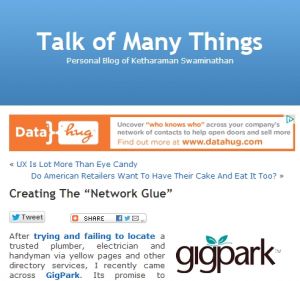When we’d daydreamed about “network glue” here last year, Datahug is exactly what we had in mind! By placing a Datahug ad on top of this post, Google AdSense agrees with us!! We can now save ourselves the trouble of building such an app and start focusing on using Datahug instead!!!
 Now that we’re done conveying our full excitement at finding an app that does what we’ve been asking for, let’s tell you more about it.
Now that we’re done conveying our full excitement at finding an app that does what we’ve been asking for, let’s tell you more about it.
This newly launched website helps salespersons minimize cold calls and, instead, “target prospects with warm introductions” by exposing “who knows who” relationships between their colleagues and the prospect they wish to reach.
Datahug quantifies the strength of these “prior connections” with a metric called “HugRank”, which helps salespersons to decide which of their fellow employees they should tap for quicker and better results with a given prospect.
Since anyone with B2B sales background would readily acknowledge that warm introductions are many times more effective at opening doors than out-of-the-blue cold calls, Datahug’s promise to “help you win business and sell more”, is highly credible.
Here are a few quick observations and comments about Datahug based on a demo and the information available on its website:
- The product video starts by showing a salesperson doing a Google Search on a company in their target account list and clicking the Team hyperlink to see who the key people in that company are. Datahug then automatically shows all prior connections with their respective HugRanks in a popup window. In today’s world, most salespersons conduct such searches on LinkedIn. It’s not clear whether similar functionality is available for LinkedIn.
- Datahug taps employees’ emails, contact lists, phone books and calendars to discover connections. While these are undoubtedly rich troves of contact information, we wonder why Datahug does not list LinkedIn Connections, Twitter Followers and Facebook Friends as potential sources. Maybe the company is aware of API tantrums thrown by the likes of LinkedIn and Twitter and is (rightly) refraining from building a business on top of an API call.
- We’d like to see a mobile version of Datahug which could be used by a salesperson while on a sales call. The salesperson receives the prospect’s business card, takes a picture of it on his or her smartphone, Datahug displays prior connections instantly. This could serve as an “ice breaker” during meetings (e.g. “Wow, so you know my colleague XYZ?”).
- Datahug is influenced by “network effect”. This vicious circle affects marketplaces (e.g. Jigsaw), user-generated content communities (e.g. Quora) and payment systems (e.g. credit cards). Whether a platform is aided or thwarted by network effect depends on how well it executes. Network Effect translates to the following situation when applied to Datahug: Enough people will use the platform only if they’re likely to find adequate number of prior connections. On the other hand, the platform can have adequate number of prior connections only if enough people use it. Datahug acknowledges this point on its FAQ page by noting, “… the more people on a customer’s network that use Datahug, the richer the network of business relationships that can be accessed”. A critical success factor for Datahug would be to find ways to accelerate the network effect to its advantage instead of getting thwarted by network effect to its dismay.
All in all, we think Datahug is a great weapon in a salesperson’s armory.
UPDATE DATED 13 JULY 2020:
It’s almost eight years since I wrote the above original post. Datahug is now part of SAP. It was acquired by CPQ software company CallidusCloud, which itself was acquired by ERP software company SAP.
